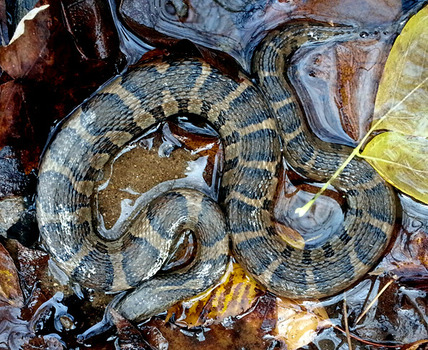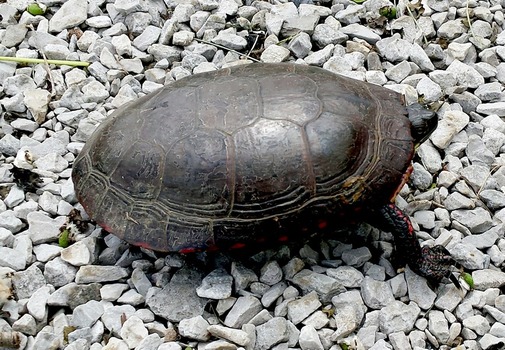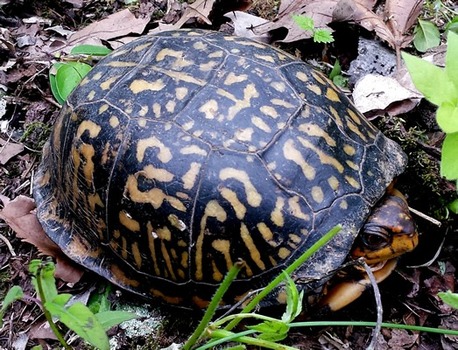Reptiles
Reptiles
Snakes
Northern Water Snake: Nerodia sipedon. Large non-venomous snake. Adults are up to five feet long. They live in or near lakes, ponds, streams, and rivers. The females give birth to live young. Each baby snake is 6 to 12 inches long. Babies are born during late summer. Parents do not provide care for the young; as soon as they are born, they are on their own.
Gray Rat Snake, Pantherophis spiloides. Large non-venomous snake. Adults are up to six feet long. Body of adults appears mostly black with a white chin and throat. Most common in forests, but found in a variety of habitats. Hibernate in dens during winter. Mate during spring, in May and June. Female usually lays 12 to 20 eggs. Eggs hatch about 10 weeks later during late summer or early fall.
Eastern Ribbon Snake, Thamnophis sauritus. Slender, medium-sized snake (up to 3 feet long) with distinct stripes on back and sides, running the length of the body. They tend to stay near water and feed largely on amphibians.
Ring-necked Snake, Diadophis punctatus. Small snake, up to 15 inches long. Secretive, nocturnal. Body is olive, brown, or black with a distinct yellow or orange neck band.
Garter Snake, Thamnophis sirtalis. Small to medium-sized snake, up to 2 feet long. Brown or green body with yellowish stripes.
Turtles
Snapping Turtle, Chelydra serpentina. Powerful beak-like jaws, highly mobile head and neck. Adults may be up to 20 inches long, 35 pounds in weight. Lives in shallow ponds or streams. Travels extensively over land to reach new habitats or to lay eggs.
Box Turtle, Terrapene carolina. Dome-like shell, up to 6 inches long. Shell is brown or black covered with yellowish lines, spots, and blotches. Males have red eyes, females have brown eyes. Front and back of ventral surface of shell are connected by a flexible hinge; turtle can close its shell by pulling hinged sections together. Lives in upland forests.
Painted Turtle, Chrysemys picta. Shell is oval, dark, smooth, up to 10 inches long. Skin is olive or black with red, orange, or yellow stripes. Lives in shallow water with slow-moving currents.
Soft-shelled Turtle, Apalone spinifera. Smooth rounded shell. Long pointed snout. Olive or tan body. Two yellow stripes along neck. Lives in rivers, lakes, ponds. Prefers open habitat with some vegetation and a sandy or muddy bottom. Feeds on aquatic insects, crayfish, small fish.



